Tristan's Endemic Finches
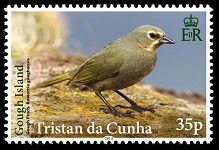 |
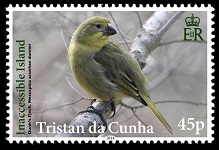 |
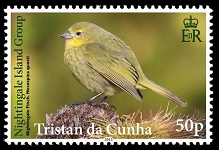 |
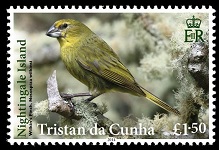 |
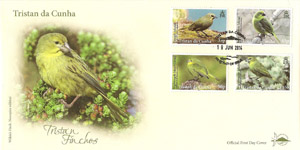 |
|
| 201409 | Mint Stamps (35p, 45p, 50p, £1.50) | £2.80 |
| 201410 | FDC with 35p, 45p, 50p, £1.50 stamps | £3.55 |
Tristan's finches traditionally were called buntings, given their resemblance to the buntings that were familiar to the early European explorers and collectors that first visited the Tristan islands. However, we now know that they are derived from South American finch-tanagers, which makes sense given that their ancestors were carried to the islands by the prevailing westerly winds. Recent studies have confirmed that the Gough Finch arose from a separate colonization event, and is more closely related to the two species of Melanodera finches from Patagonia and the Falkland Islands than it is to the finches at Tristan. As a result, it is sensible to retain it in its own genus, Rowettia, named after John Quiller Rowett, the sponsor of Shackleton's last expedition, which called at Gough in mid-1922 after Shackleton's death.
As the only songbird on Gough (and indeed one of only two land birds), the Gough Finch has evolved a large body and a long, slender bill to exploit a wide range of ecological roles. It spends much of its time probing among vegetation for invertebrates, but like many island birds, has a catholic diet including fruits, seeds and even carrion from bird carcasses killed by Subantarctic Skuas. The sexes are similar in appearance, but the juveniles are quite distinct, with heavily streaked plumage. They appear so different that initially they were described as a separate species. Unfortunately, Gough Finches are now scarce on Gough Island, being largely confined to sheer coastal cliffs and high mountainous areas where they find some refuge from introduced House Mice. The mice prey on the finch's chicks (and those of many seabird species), resulting in the finch being listed as Critically Endangered.
Tristan's finches are equally susceptible to introduced predators. They once occurred at all three islands in the Tristan group, but died out on the main island of Tristan within 50 years of the island's colonization in 1810. The reasons for their demise are still not fully resolved; they disappeared before the introduction of rats and widespread habitat loss to agriculture. However, mice reached Tristan prior to their extinction, and so may have played a key role, just as they now threaten the Gough Finch. Only once specimen from the main island survives - the type, housed in Berlin. Fortunately, Inaccessible and Nightingale Island lack introduced mammals, and so still support healthy populations of finches.
Tristan's finches are arguably less attractive than the Gough Finch, but they are more interesting from an evolutionary perspective. For many years only two species were recognized: a common, small-billed dietary generalist, and a rare, large-billed specialist whose bill has evolved to crack open the woody nuts of the Island Tree Phylica arborea. The two species clearly are each other's closest relatives, and they thus form a miniature example of an adaptive radiation, epitomized most famously by Darwin's finches of the Galapagos Islands. The renowned ornithologist David Lack, who published the classic account of the evolution of Darwin's finches in 1947, was quick to point out the potential importance of the modest radiation among Tristan's finches in teasing apart how species arise. However, the remoteness of especially the uninhabited islands prevented serious study of the finches until the 1980s.
Contrary to expectations, recent research has shown that large- and small-billed forms at each island are each other's closest relatives, and thus it is likely that the two bill morphs have evolved separately on each island. Similar examples of parallel evolution have since been recorded in other island systems, revolutionizing the way we think about the speciation process. Given this unexpected finding, three species are now recognized.
At tiny Nightingale Island, the two bill morphs are quite distinct and so are recognized as separate species. At larger Inaccessible Island, however, the two forms remain largely discrete in coastal habitats, but they hybridise extensively on the island plateau, and thus are best treated as a single species with multiple morphs or subspecies. Time will tell whether this extraordinary example of evolution in action will eventually lead to complete segregation, remain as it is, or blur into a single form.
Text by Professor Peter Ryan, Director of the Percy FitzPatrick Institute, University of Cape Town.
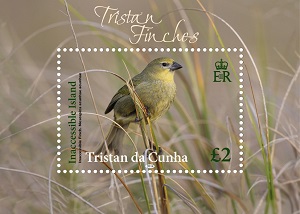 |
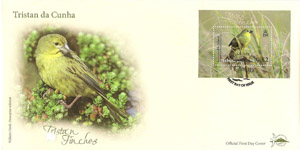 |
|||||
|
Technical Specifications from Pobjoy Mint Ltd.
Designer: Bee Design – Photography: Peter Ryan
Printer: BDT International Security Printing Ltd – Process: Lithography
Stamp size: 28.45 x 42.58mm – S/S size: 70 x 50mm
Perforation: 14 per 2cms – Stamp Layout: 10
Production Co-ordination: Creative Direction (Worldwide) Ltd
